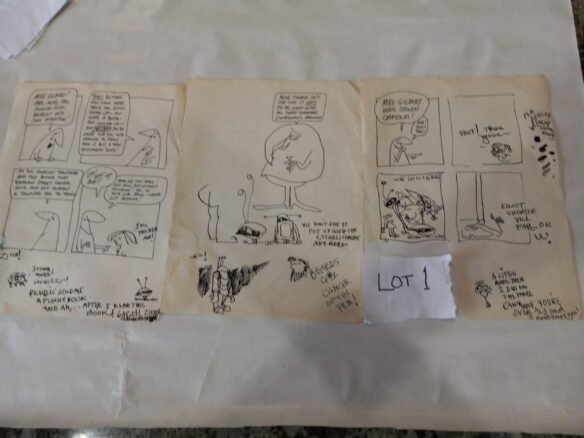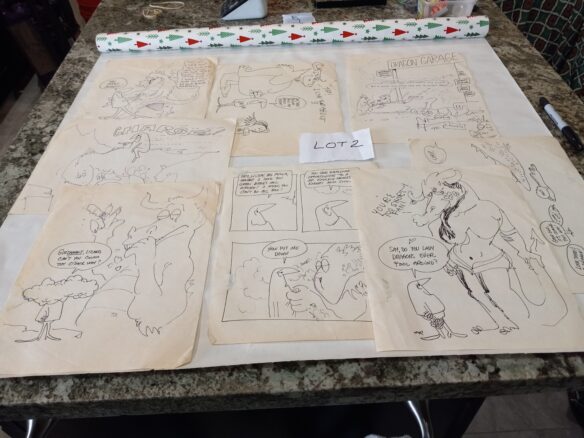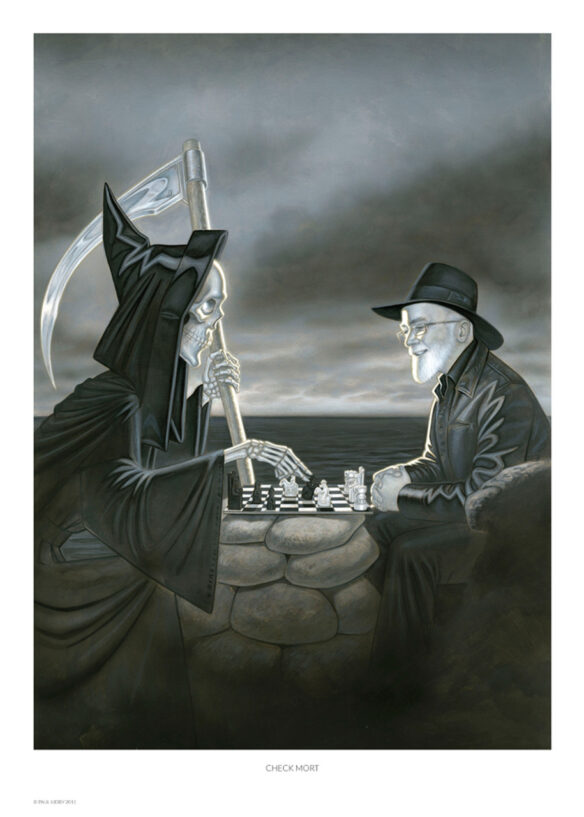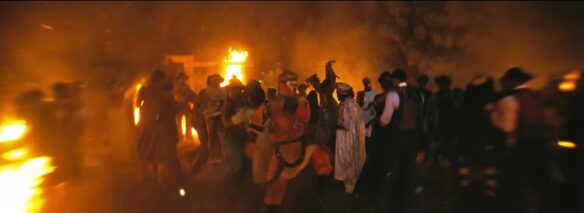(1) ARTHUR C. CLARKE SHORTLIST. The Arthur C. Clarke Award 2025 Shortlist was announced today. File 770 lists the six finalists at the link.
(2) HAPPY 90TH! On Wednesday May 14 “Griffith Observatory celebrates 90th birthday” reports LAist. (The official website with more detail about the celebration is here: “Griffith Observatory – Southern California’s gateway to the cosmos!”)
A star was born in 1935, when Griffith Observatory became the first public observatory west of the Mississippi.
Now, “Griffith Observatory is the most visited public observatory on the planet,” says Ed Krupp, longtime director of the observatory.
In the 90 years since its founding, more than 7 million people have peered through the historic Zeiss telescope that adorns the peak of Mount Hollywood in Griffith Park.
“More than any other telescope on Earth,” Krupp adds.
Celebrations kick off with a special opening ceremony on the observatory’s front lawn at 11:30 a.m., before doors open at noon. Visitors will receive limited-edition 90th anniversary buttons while supplies last.
Throughout the day, the observatory will host special programming highlighting both astronomical phenomena and the building’s history as a center for public astronomy.
“People on site will get to see how the sky really works,” Krupp said. “It’s a reminder that the observatory itself is an instrument.”
In the evening, a program in the Leonard Nimoy Event Horizon Theater will honor California’s Indigenous astronomical traditions. And visitors will gather on the West Terrace to salute the sunset “as the sun salutes Griffith Observatory’s birthday,” Krupp said. “It’s a cosmic party.”
As night falls, the celebration will continue with a rare event: the Southern Major Standstill Moonrise, part of an 18.6-year lunar cycle. The event will also be live-streamed on Instagram.
(3) IT’S BOT TIME. NPR’s TV reviewer says this is what to watch for: “On TV this week: ‘Murderbot’ and a Joan Rivers tribute on NBC”.
Think back to a time about six years ago, before the explosion of streaming services that included Apple TV+, and it’s tough to imagine a TV show like Murderbot getting made.
Not just because its star, dreamboat actor Alexander Skarsgård, might be more focused on big films. But because the eye-popping special effects and high-quality production involved in developing a project from Martha Wells’ ambitious science fiction novel series The Murderbot Diaries might be a stretch even for a major motion picture – let alone a TV series on a platform that struggles to build big hits.
In fact, Murderbot is the latest example of a trend I’ve noticed on streaming TV – exquisitely produced science fiction and fantasy shows that may not be seen outside of a small-yet-passionate fanbase.
Apple TV+’s Murderbot, debuting Friday, has quite a few hallmarks of high-quality TV. Not only is Skarsgård magnificent in playing a cyborg who has secretly become an independent, free thinking artificial being – he’s in a series created and executive produced by Chris and Paul Weitz, brothers who worked on acclaimed films like About a Boy and American Pie….
…It’s an innovative, creative story told in 10 short episodes, satirizing everything from ruthless corporatism to blithely naive social justice stands. And it will be catnip for science fiction fans who love all the actors who pop up in it. But it’s also not likely to get wide viewing, because Apple TV+ has made a habit of spending loads of money on beautifully shot science fiction stories that have a tough time making a wide impact….
(4) PARTING SHOT. The release of the pre-publication version of the third part of the Copyright Office’s report “Copyright and Artificial Intelligence” came the day before — “Copyright Chief Fired Amid AI Debate”. Publishers Weekly reports on the suspicious move.
On Saturday, the Trump administration fired Shira Perlmutter, the register of copyrights and director of the U.S. Copyright Office, just two days after the dismissal of Librarian of Congress Carla Hayden, under whose auspices the U.S. Copyright Office operates. Perlmutter was appointed by Hayden in 2020….
… The move, like Hayden’s dismissal before it, was immediately blasted by Democratic members of Congress. Rep. Joe Morelle (Dem., N.Y.), the top Democrat on the Committee on House Administration, called the move “a brazen, unprecedented power grab with no legal basis,” adding, “It is surely no coincidence he acted less than a day after she refused to rubber-stamp Elon Musk’s efforts to mine troves of copyrighted works to train AI models.”
On Friday, Perlmutter’s office released the pre-publication version of the third part of the Copyright Office’s report “Copyright and Artificial Intelligence,” following a first segment released in July 2024 and a second released this January. This third part focuses on the impact of generative AI training across a wide range of topics, from the origins of the technology, to AI companies’ possible infringement in training their data sets, to those companies’ defense that the training counts as fair use, to what potential licensing scenarios might look like.
Morelle and others have speculated that Perlmutter’s dismissal was likely due to her release of the preliminary report. But sources close to the office, who spoke with PW on condition of anonymity, suggest that it is more likely that Perlmutter, having heard of her impending dismissal, ordered the report released beforehand to ensure it entered the public record in spite of its incomplete status. (The report, for instance, lacks some citations.)…
(5) POSTER BOY. “’I add the human touch’: the beautiful, bespoke work of Berlin’s last cinema poster artist” – a Guardian profile.
Götz Valien is Berlin’s last movie poster artist, for more than three decades earning a modest living producing giant hand-painted film adverts to hang at the city’s most beloved historic cinemas – a craft he says will probably die with him, at least in western Europe. The studios’ own promotional posters serve as a template, but Austrian-born Valien, 65, adds a distinctive pop art flourish to each image coupled with the beauty of imperfection – part of the reason he has managed to extend his career well into the 21st century.
“Advertising is about drawing attention and I add the human touch, which is why it works,” he said. Valien’s work plays up the image’s essence: the imposing bow of a ship, the haunting eyes of a screen siren, a mysterious smile. He jokingly calls himself a Kinosaurier – a play on the German words for cinema and dinosaur….
(6) TODAY’S BIRTHDAY.
[Written by Paul Weimer.]
May 13, 1937 — Roger Zelazny. (Died 1996).
I’ve mentioned many times that Roger Zelazny, in conjunction with Tolkien, got me into fantasy. And you’ve possibly read my reviews of the collected Roger Zelazny short stories here at File 770. Or one of my many other reviews in various places over the years.
So what else can I tell you about my relationship with Zelazny that you haven’t read already? Surely you know that I started with Zelazny’s work with Nine Princes in Amber, and so with Zelazny, I gained a permanent love of multiversal fiction that would lead me to Moorcock and many other authors in due course. Amber also was one of my entry points into RPGs and so along with D&D, and Traveller, and Call of Cthulhu, there was the tiny but influential Amber Diceless Roleplaying Game. So Zelazny has been always a part of my RPG life.
Imagery. Powerfully invoked scenes. Poetic prose (the collected Zelazny, with his poetry, was revelatory as to where all that came from). Sharp archetypal characters, that feel like they came out of a tarot deck (or a Trump deck?) As a stylist, in my personal constellation of reading, he has no equal.
As I have said in my reading of the collections, I inadvertently stumbled upon many Zelazny stories outside of his novels when I was young, and not knowing what they really were. There are several Zelaznys inside of himself, as he changed, evolved and always trying new things. The author of Amber is also the author of Damnation Alley and also the author of Lord of Light and also the author of “24 views of Mount Fuji, by Hokusai”. All of these are very different, and yet indubitably Zelazny.
Zelazny has been part of my reading since the beginning of my SFF reading, and will continue to do so for as long as I have strength. For as long as I have that strength, I will keep walking that Road to Amber, revisiting the sights and wonders Zelazny has left for us along the way.
I never got to meet him, alas. Requiescat in pace

(7) COMICS SECTION.
- Bob the Angry Flower tries to free a prisoner.
- Brewster Rockit shows how far the problem extends.
- Dinosaur Comics knows some tales are scarier than others.
- Dog Eat Doug’s cats prefer science.
- Free Range remembers the thing no one ever went broke doing.
- Non Sequitur can’t decide if this is about romance or politics.
- Saturday Morning Breakfast Cereal wants to pass on a trait.
(8) ON A MISSION. James Bacon’s article “The Leprechaun, and the Irish War on Comics” at downthetubes.net is a companion piece to his article here, “Greann — Ireland’s First Comic Book, from a veteran of the 1916 Rising”.
With its colourful front cover and striking red masthead The Leprechaun may have seemed very attractive to children in 1953, and this tabloid-sized Irish comic feels like it may have been influenced by and created to compete with the likes of the British comic Eagle – but in actual fact it was not, although its publisher, like the Eagle’s editor, the Reverend Marcus Morris, did have similar aims. The Leprechaun was also created to combat “the outcry against the harm being done by imported comics” and to provide for “the need for clean comics” for Irish readers.
As Mr. French of Bray Urban District Council noted about American Comics they “were nothing but sensual cesspools of iniquity” when he proposed a resolution calling on the Minister for Justice to ban the importation of all comics emanating from American publishers (reported in the Irish Independent on Wednesday, 11th June 1952).
The Horror Comics Campaign in Britain that the late Martin Barker so brilliantly wrote of in A Haunt of Fears encompassed a movement between 1949 and 1955 that brought about the Children and Young Persons (Harmful Publications) Act of 1955. The fear was mirrored in Ireland, and comics continually featured in contemporary newspaper reports across the country.
On 8th November 1952, the Connacht Tribune reported about the “COMICS: DÁIL QUESTION” with the Minister for Justice responding to a question with, “I have no information that objectionable comics are printed in Ireland.”
Into this hot fray of emotion, intellectual anxiety and fear of God, the first issue of the fortnightly comic The Leprechaun was published in early July 1953…..

(9) IF LOVING YOU IS A CRIME, I’LL ALWAYS BE GUILTY. [Item by Steven French.] As with fantasy, so with games – GTA comes over all romantic: “GTA6 gets it on: can the notoriously cynical action series finally find time for romance?” asks the Guardian.
Something new is coming to the Grand Theft Auto universe next year. I don’t mean super-high-definition visuals, or previously unexplored areas of Rockstar’s take on the US. This time it’s something much more profound. If you’ve seen the newly released second trailer from GTA6 – somewhat cruelly released just days after we discovered the game won’t be out until next May – then you might know what I mean. The brand new thing is romance.
It’s now clear that the key protagonists of the latest gangland adventure are Lucia Caminos and Jason Duval, two twentysomething lovers from the wrong side of the tracks. He’s ex-army, now working for drug runners; she’s fresh out of jail, looking to make a better life for herself and her beloved mom. They fall for each other, hatch a plan to get out of Vice City, and then when their simple heist goes wrong, they find themselves at the sharp end of a state-wide conspiracy. You always knew that if Rockstar were going to tell a love story, it would involve a formidable cast of underworld kingpins, gang members, conspiracy nuts and corrupt politicians, and you were right….
(10) OLD IN NEW YORK. Deadline is there when “Nicolas Cage Makes Photo Debut As Aging Web Slinger in ‘Spider-Noir’”.
Nicolas Cage made his photo debut in Spider-Noir at Amazon’s annual upfronts presentation this afternoon and can be seen below. Spider-Noir will be available in both black and white and color when it premieres in 2026.
The live-action series from MGM+ and Prime Video, based on the Marvel comic Spider-Man Noir, tells the story of an aging and down-on-his-luck private investigator (Cage) in 1930s New York, who is forced to grapple with his past life as the city’s one and only superhero….
(11) ANIME MVP’S. “MLB Anime: Heroes of the Game (ft. Shohei Ohtani, Aaron Judge, more!)”
MLB has teamed up with a crew of creators from the world of anime, tapping animators from One Piece and Full Metal Alchemist to release Heroes of the Game! The power, precision, and skill needed for MLB players to reach the top of their game is almost superhuman. Now, that intensity is being showcased through the world of anime—connecting fans from America, Japan, the UK, and beyond. The campaign features Shohei Ohtani as the Master of Both Sides of the Game, Paul Skenes as the pitcher with ferocious power to unleash, Aaron Judge as the Herculean hitter on a mission to become one of the all-time greats, and Juan Soto as the man who sees all and can change the game with just one swing.
(12) VIDEO OF THE DAY. [Item by SF Concatenation’s Jonathan Cowie.] Isaac Arthur’s latest video title made me think of J. G. Ballard’s book. However I am not sure I buy into the concept of complex crystal biology as Isaac does. (Though I loved Crichton’s The Andromeda Strain.) “Crystal Aliens: Life, But Not As We Know It”.
Crystals are not alive, yet they grow, form complex structures, and even conduct electricity. Could life emerge from crystals rather than carbon-based molecules? Explore the intriguing possibility of crystal-based lifeforms, the challenges they would face, and the conditions where they might thrive. We journey to five exotic worlds—Vulcan, Ribbon World, Longenacht, Telluride, and Tempest—each offering unique environments where crystalline life might take hold. Could such life develop naturally, or might humanity one day engineer it? Join us as we dive into the cutting-edge science and speculative possibilities of crystalline biology.
[Thanks to Andrew Porter, John King Tarpinian, Chris Barkley, Paul Weimer, Cat Eldridge, SF Concatenation’s Jonathan Cowie, Mark Roth-Whitworth, Steven French, Kathy Sullivan, Teddy Harvia, and Mike Kennedy for some of these stories. Title credit belongs to File 770 contributing editor of the day Daniel Dern.]
































